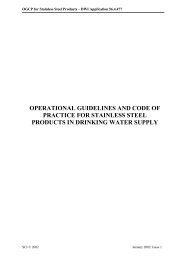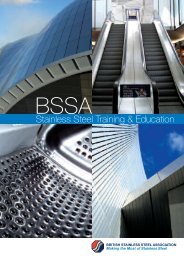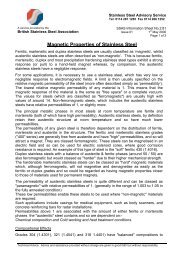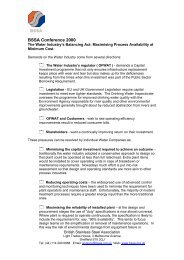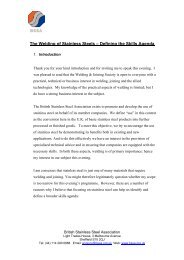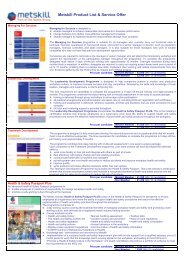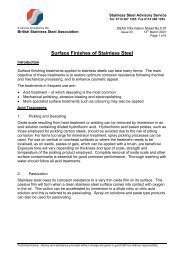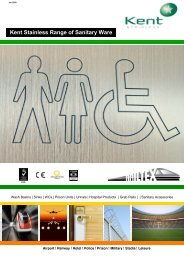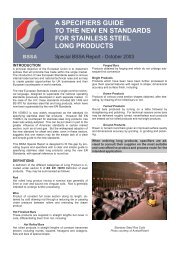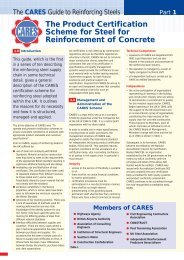Dry ice blasting of stainless steel - British Stainless Steel Association
Dry ice blasting of stainless steel - British Stainless Steel Association
Dry ice blasting of stainless steel - British Stainless Steel Association
Create successful ePaper yourself
Turn your PDF publications into a flip-book with our unique Google optimized e-Paper software.
<strong>Dry</strong> <strong>ice</strong> <strong>blasting</strong><br />
<strong>of</strong> <strong>stainless</strong> <strong>steel</strong><br />
By N.W. Buijs, Van Leeuwen <strong>Stainless</strong>, The Netherlands<br />
There are many misconceptions<br />
surrounding the corrosion performance<br />
<strong>of</strong> <strong>stainless</strong> <strong>steel</strong> in seawater, as<br />
well as its use in the vicinity <strong>of</strong> the<br />
coast. It is generally claimed that<br />
AISI 316 <strong>stainless</strong> <strong>steel</strong> is suitable<br />
for use in maritime environments,<br />
but this is somewhat open to discussion<br />
as, more <strong>of</strong>ten than not, it<br />
leads to problems. At times it<br />
appears that AISI 316 <strong>stainless</strong> <strong>steel</strong>,<br />
which has been immersed in cool,<br />
aerated seawater, does perform well,<br />
while suffering moderate to severe<br />
corrosion when used in coastal<br />
areas. The latter is usually caused by<br />
so-called “aerosols”, which are<br />
droplets <strong>of</strong> seawater transported<br />
from the sea by wind. During their<br />
journey by air, these droplets evaporate<br />
slightly, increasing their concentration<br />
<strong>of</strong> salt, which gives them<br />
their destructive quality. Once corrosion<br />
has occurred, the flash rust<br />
which has developed can be eliminated<br />
using an effective technique<br />
available nowadays known as dry<br />
<strong>ice</strong> <strong>blasting</strong>.<br />
Picture 1. A <strong>stainless</strong> <strong>steel</strong> AISI 316 post,<br />
where all but the polished cap is<br />
corroded.<br />
In external environments, <strong>stainless</strong><br />
<strong>steel</strong> can sometimes suffer severe<br />
corrosion. Nevertheless, as a rule, its<br />
performance rates between good<br />
and excellent. The latter is especially<br />
true when using AISI 316; particularly<br />
in inland areas. Problems<br />
mainly arise along the coastline,<br />
next to railways, and sometimes<br />
also close to aggressive gas emissions<br />
from factories and vehicles.<br />
Another important contributing<br />
factor is the condition <strong>of</strong> the material’s<br />
surface; the smoother the surface,<br />
the greater the material’s<br />
resistance to corrosion. This is also<br />
the reason why ground <strong>stainless</strong><br />
<strong>steel</strong> corrodes relatively quickly in<br />
maritime environments, while polished<br />
surfaces remain in good condition.<br />
Picture 1 contains an example<br />
<strong>of</strong> this – the ground tube <strong>of</strong> the<br />
post is somewhat corroded, whereas<br />
the polished cap appears to be<br />
untarnished. This post is situated<br />
on a boulevard along the coast.<br />
The degree to which ground <strong>stainless</strong><br />
<strong>steel</strong> is resistant to corrosion<br />
partly depends upon the grit size<br />
used. The finer the grit, the greater<br />
the corrosion-resistance. One disadvantage<br />
<strong>of</strong> grinding compared to<br />
pickling, is that grinding can<br />
expose small areas which are less<br />
resistant to corrosion; these then<br />
act as entry points for local attack.<br />
If the grit used is too coarse, dirt<br />
deposits can collect in the grooves,<br />
which can also trigger corrosion;<br />
this is especially true in seawater<br />
and chloride-containing environments.<br />
The reason for this is that<br />
small chloride ions can penetrate a<br />
lot deeper under dirt deposits than<br />
the relatively larger oxygen molecules.<br />
This is also known as ‘under<br />
deposit corrosion’. A clear example<br />
<strong>of</strong> this could be seen on a passenger<br />
ship fitted with highly polished<br />
AISI 316 railings. After it became<br />
apparent that the sun’s reflection<br />
was causing too much <strong>of</strong> a nuisance<br />
to passengers, it was decided to<br />
replace these railings with ground<br />
K320 tubes made from AISI 316.<br />
After three months, rusty patches<br />
started to appear in several places<br />
on the tubes, leading the shipping<br />
company to believe that AISI 304<br />
had mistakenly been supplied<br />
instead <strong>of</strong> 316. After investigation,<br />
this was found not to be the case;<br />
instead, it was the surface condition<br />
<strong>of</strong> the tubes which was responsible<br />
for this phenomenon. There was no<br />
other cho<strong>ice</strong> than to use scouring<br />
pads to remove the flash rust from<br />
the tubes. The annoying part is that<br />
this now has to be done on a regularly<br />
basis while polished tubes are<br />
virtually maintenance-free.<br />
CLEANING METHODS<br />
For experienced users, surface rust<br />
on <strong>stainless</strong> <strong>steel</strong> is no surprise;<br />
however, removing it remains a<br />
labour-intensive and <strong>of</strong>ten environmentally-unfriendly<br />
process. The<br />
latter is certainly the case when special<br />
cleaning acids are applied,<br />
which, although effective, will<br />
attack the surface further if used for<br />
a prolonged period <strong>of</strong> time, causing<br />
new flash rust to develop at a faster<br />
rate. Thorough rinsing is therefore<br />
required, and care must be taken to<br />
safeguard the environment, not to<br />
mention minimising health risks.<br />
A better method would be to use<br />
cleaning and scouring products<br />
with the necessary caution. There is<br />
a real risk <strong>of</strong> causing permanent<br />
scratching to the object, with an<br />
adverse affect on its appearance.<br />
Another downside is that these<br />
ARCHITECTURE<br />
www.<strong>stainless</strong>-<strong>steel</strong>-world.net<br />
S T A I N L E S S S T E E L W O R L D A P R I L 2 0 0 6<br />
31
ARCHITECTURE<br />
Picture 3. Flash rust already visible after<br />
a month, particularly by the welds.<br />
Picture 2. Wind barrier made from<br />
<strong>stainless</strong> <strong>steel</strong> 316L.<br />
methods are very labour-intensive<br />
and need to be repeated on a regular<br />
basis. In addition, certain<br />
requirements would need to be stipulated<br />
regarding the type <strong>of</strong> scouring<br />
product to be used, to avoid the<br />
possible problems as described<br />
above. It is therefore important to<br />
consider innovations in contaminant<br />
removal. One such method,<br />
which is particularly noteworthy, is<br />
the use <strong>of</strong> dry <strong>ice</strong> <strong>blasting</strong>.<br />
very user-friendly. Furthermore, as<br />
the carbon dioxide is created during<br />
the production <strong>of</strong> industrial gases,<br />
the CO2 is returned to the atmosphere,<br />
making dry <strong>ice</strong> <strong>blasting</strong> a<br />
very environmentally-friendly<br />
process. The following lists the<br />
main features <strong>of</strong> this method:<br />
additional investment, it would<br />
therefore be better to leave this task<br />
to specialist companies.<br />
There are three main stages to<br />
cleaning with dry <strong>ice</strong>:<br />
1. Mechanical: the dry <strong>ice</strong> pellets<br />
accelerate in the air stream and<br />
DRY ICE BLASTING<br />
<strong>Dry</strong> <strong>ice</strong> <strong>blasting</strong>, also known as<br />
cryogenic <strong>blasting</strong>, is a cleaning<br />
process whereby compressed frozen<br />
carbon dioxide (CO2), or dry <strong>ice</strong>, is<br />
allowed to sublimate under high<br />
pressure on a contaminated or<br />
lightly rusted surface. A high-pressure<br />
jet is used to blast the <strong>ice</strong>, at a<br />
temperature <strong>of</strong> -79° C, onto a contaminated<br />
<strong>stainless</strong> <strong>steel</strong> surface,<br />
which is warm by comparison. This<br />
then causes a ‘thermo shock’,<br />
which considerably loosens any<br />
contamination and flash rust, and<br />
the dry <strong>ice</strong> evaporates instantly. The<br />
dry <strong>ice</strong> rapidly converts into carbon<br />
dioxide gas and expands about 700<br />
times in volume. This produces a<br />
sort <strong>of</strong> explosion on the surface,<br />
which thoroughly removes all contaminants.<br />
As carbon dioxide has<br />
no liquid state, there is no moisture<br />
to be found, which explains the<br />
term ‘dry <strong>ice</strong>’. A significant advantage<br />
is that no damp residue is left<br />
behind which makes this method<br />
Picture 4. Rust pits showing on the design’s posts.<br />
• A quick, dry process;<br />
• No addition <strong>of</strong> chemicals;<br />
• Non-toxic, therefore kind to users<br />
as well as the environment;<br />
• No waste;<br />
• No disassembly <strong>of</strong> equipment<br />
required before cleaning,<br />
enabling higher productivity;<br />
• No scouring effect, so no surface<br />
damage;<br />
• Cost savings.<br />
The only drawback is that special<br />
equipment is required. To avoid<br />
hit the contaminants at high<br />
velocity, removing the majority<br />
<strong>of</strong> them;<br />
2. Thermal: the low temperature <strong>of</strong><br />
the dry <strong>ice</strong> makes the material to<br />
be removed more brittle, aiding<br />
its further removal (thermo<br />
shock);<br />
3. Sublimation: the rapid conversion<br />
<strong>of</strong> the solid dry <strong>ice</strong> into gas<br />
produces an explosion on the<br />
surface, eliminating the remaining<br />
contaminants and rust.<br />
▲<br />
32 S T A I N L E S S S T E E L W O R L D A P R I L 2 0 0 6 www.<strong>stainless</strong>-<strong>steel</strong>-world.net
ARCHITECTURE<br />
rust was removed effectively within<br />
a relatively short period <strong>of</strong> time,<br />
although it had already been left a<br />
little too late. In other words, rust<br />
should be treated as soon as it is<br />
discovered. Pictures 5 and 6 show<br />
the result <strong>of</strong> dry <strong>ice</strong> <strong>blasting</strong>, which<br />
can be compared to the contents in<br />
pictures 3 and 4. It goes without<br />
saying that the difference shown is<br />
remarkable, if not unbelievable.<br />
Even the toughest rust in the<br />
CASE STUDY<br />
One example that appeals to the<br />
imagination is that <strong>of</strong> a 400 m2<br />
wind barrier made from <strong>stainless</strong><br />
<strong>steel</strong>, situated on a boulevard along<br />
the coast (Picture 2). A month after<br />
being placed, this 316L <strong>stainless</strong><br />
<strong>steel</strong> barrier was already exhibiting<br />
patches <strong>of</strong> corrosion (Pictures 3 and<br />
4). The cause <strong>of</strong> this was indeed<br />
found to be the force <strong>of</strong> the aggressive<br />
aerosols. The rate <strong>of</strong> corrosion<br />
was also accelerated by the material’s<br />
surface condition, as well as the<br />
incorrect attachment <strong>of</strong> the perforated<br />
plates to the tubes, which<br />
enabled moisture to collect (Picture<br />
3). Although it may seem that the<br />
cho<strong>ice</strong> <strong>of</strong> material was incorrect, if<br />
the surface had been polished and<br />
there had been no crev<strong>ice</strong>s, 316L<br />
could, in principle, have been used<br />
successfully. Another not<strong>ice</strong>able<br />
thing was that welding had been<br />
carried out intermittently. Furthermore,<br />
the welds were pock-marked<br />
and irregular; a result <strong>of</strong> applying<br />
the MIG welding process, which is<br />
preferable to TIG welding when<br />
joining perforated plates.<br />
It would also have been better to<br />
insert slots in those places not<br />
requiring welding, to prevent moisture<br />
collection, which did occur in<br />
this example. Perforations <strong>of</strong>ten<br />
have rough edges, which are caused<br />
when holes are punched out; this is<br />
not very conducive to corrosionresistance.<br />
It would have been<br />
Picture 6. No more rust between the plates and tubes.<br />
preferable to have had laser-cut<br />
holes. Once more, this demonstrates<br />
the importance <strong>of</strong> clear communication<br />
between the metallurgist,<br />
the designer and the company<br />
commissioned to produce the<br />
object. In this case, there was a lack<br />
<strong>of</strong> communication, which meant<br />
consequences had to be faced sooner<br />
or later. Again, a lot <strong>of</strong> trouble<br />
could have been spared.<br />
Actually, dry <strong>ice</strong> <strong>blasting</strong> <strong>of</strong> <strong>stainless</strong><br />
<strong>steel</strong> is still an unexplored area and<br />
initial results have therefore proven<br />
to be particularly encouraging. The<br />
rust must only be superficial, otherwise<br />
scars would be left by the corrosion,<br />
seeing as the process does<br />
not remove any <strong>of</strong> the underlying<br />
material. This method is therefore<br />
primarily intended to combat flash<br />
rust, which has not been left on the<br />
surface long enough to cause further<br />
corrosion.<br />
In the case <strong>of</strong> the wind barrier, the<br />
crev<strong>ice</strong>s has been eliminated. <strong>Dry</strong><br />
<strong>ice</strong> <strong>blasting</strong> is therefore expected to<br />
play a significant part in the future<br />
<strong>of</strong> <strong>stainless</strong> <strong>steel</strong> cleaning.<br />
POST-TREATMENT<br />
Despite thorough cleaning with dry<br />
<strong>ice</strong> <strong>blasting</strong>, the surface will still<br />
contain weak spots, which may corrode<br />
quickly again in future. After<br />
dry <strong>ice</strong> <strong>blasting</strong>, it is a good idea to<br />
apply a post-treatment to the surface<br />
to prevent the development <strong>of</strong><br />
any new rust. This is particularly<br />
important in maritime environments.<br />
For this purpose, good,<br />
inherent coatings have been developed,<br />
which are also transparent<br />
and colourless, ensuring that the<br />
“<strong>stainless</strong> <strong>steel</strong> look” is maintained.<br />
These coatings are predominantly<br />
naphtha-based and are extremely<br />
difficult to remove, even with hot<br />
water and thinner. This enables<br />
them to provide lasting protection.<br />
A protective coating was applied to<br />
34<br />
S T A I N L E S S S T E E L W O R L D A P R I L 2 0 0 6 www.<strong>stainless</strong>-<strong>steel</strong>-world.net
the aforementioned wind barrier<br />
after it had been cleaned with dry<br />
<strong>ice</strong> <strong>blasting</strong>, but as you can deduce<br />
from pictures 5 and 6, this treatment<br />
remains invisible. This coating<br />
can easily be applied using a<br />
dispenser and its protective qualities<br />
emerge once it is ‘hardened’.<br />
The question remains, however,<br />
whether this technical wax <strong>of</strong>fers<br />
sufficient protection in the crev<strong>ice</strong>s<br />
between the perforated plates and<br />
the tubes. If in doubt, it would be<br />
better to apply a transparent and<br />
colourless sealant to these areas.<br />
About the author<br />
Ko Buijs is a recognized metallurgical<br />
/ corrosion specialist on<br />
<strong>stainless</strong> <strong>steel</strong>s as well as special<br />
metals. He works for Van<br />
Leeuwen <strong>Stainless</strong>. In addition, Mr<br />
Buijs is a lecturer for various<br />
organisations such as <strong>steel</strong> associations,<br />
technical high schools and<br />
innovation centres. He has published<br />
over 100 papers in a number<br />
<strong>of</strong> technical magazines. In<br />
close co-operation with Barsuk<strong>of</strong>f<br />
S<strong>of</strong>tware Mr Buijs has developed<br />
the computer programme Corrosion<br />
Wizard 2.0. Info www.corrosionwizard.com<br />
CONCLUSION<br />
In principle, dry <strong>ice</strong> <strong>blasting</strong> makes<br />
it possible to restore contaminated<br />
<strong>stainless</strong> <strong>steel</strong> to a high standard, as<br />
long as the entire surface is then<br />
coated with a colourless and transparent<br />
adhesive coating, paying<br />
particular attention to any weak<br />
areas. Another prerequisite is that<br />
corrosion has not caused excessive<br />
damage to the <strong>stainless</strong> <strong>steel</strong>, as this<br />
would leave too many scars. <strong>Dry</strong> <strong>ice</strong><br />
<strong>blasting</strong> is relatively cheap compared<br />
to chemical treatments,<br />
which also carry the risk <strong>of</strong> acid<br />
residues remaining and increasing<br />
the likelihood <strong>of</strong> new patches <strong>of</strong><br />
corrosion. If you would like to<br />
receive more information about this<br />
process or a list <strong>of</strong> companies providing<br />
this serv<strong>ice</strong>, please send an e-<br />
mail to: nwbuijs@hetnet.nl. All in<br />
all, it can be said that dry <strong>ice</strong> <strong>blasting</strong><br />
will play a significant role in<br />
the cleaning <strong>of</strong> <strong>stainless</strong> <strong>steel</strong> in<br />
future.



